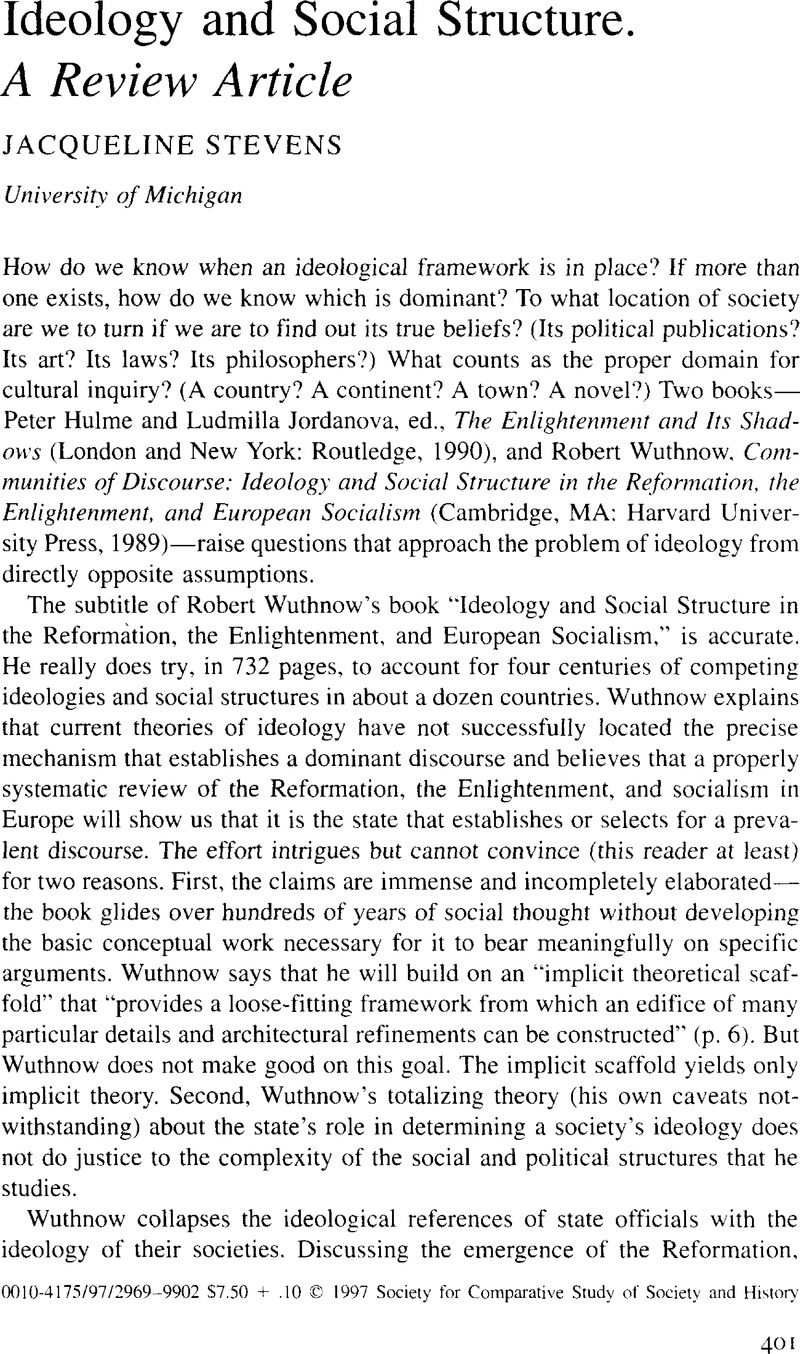No CrossRef data available.
Published online by Cambridge University Press: 25 April 2012

1 That the United States in the 1990s is a more differentiated society than the ones Wuthnow considers is certainly a possibility. However, Wuthnow does not dispute the fact that competing ideologies are circulating among his patrons of history. My intent is to raise theoretical questions that Wuthnow's methodology does not address. The United States has a two-party system that supposedly mitigates against an ideological state, and. further, the public here has a reputation for being non-ideological altogether. Hence sharp disputes found here may be especially instructive on the weakness of Wuthnow's thesis, although any findings with respect to religion would have to be evaluated in the context of American “exccptionalism.” (For an argument that it is European secularization that is exceptional, see Casanova, Jose, Public Religions in the Modern World (Chicago and London: University of Chicago Press, 1994), 28.Google Scholar)
2 The Religious Right: The Assault on Tolerance and Pluralism in America (New York: Anti-Defamation League, 1994)Google Scholar, quoting sermon, March, 1993.
3 The Dominant Ideology Thesis, 75, 77 (London: George Allen and Unwin. 1980)Google Scholar.
4 Ibid. p. 77. See also David Martin. A Sociology of English Religion (New York: Basic Books, 1967); The Religious and the Secular: Studies in Secularization (London: Routledge and Kegan Paul, 1969)Google Scholar: and Thomas, Keith, Religion and the Decline of Magic (New York: Scrihner, 1971)Google Scholar.
5 All statistics on attitudes in this essay are from the 1992 National Election Study. Institute of Survey Research, University of Michigan, Ann Arbor.
6 Wuthnow is no stranger to the tensions in the United States on the matter of religion. It is strange that the state-society split he acknowledges in his other books does not guide his analysis in this one. See Experimentation in American Religion: the New Mysticisms and Their Implications for the Churches (Berkeley: University of California Press, 1978)Google Scholar: The Restructuring of American Religion: Society and Faith since World War Two (Princeton: Princeton University Press, 1988)Google Scholar: The Struggle for America's Soul: Evangelicals, Liberals, and Secularism (Grand Rapids: W.B. Eerdmans. 1989)Google Scholar.
7 United States Senate, Committee on Labor and Human Resources, Report on the Freedom of Access to Clinical Entrance Act, 1993 (July 29, 1993), (Washington, D.C.: GAO. 1993), note 29.
8 Key books on this topic include Ashley, Roger, The Atlantic Slave Trade and British Abolition, 1760–1810 (New York: MacMillan, 1975)Google Scholar; Davis, David Brion, The Problem of Slavery in Western Culture (Ithaca: Cornell University Press, 1966)Google Scholar, especially pt. III; Davis, , The Problem of Slavery in the Age of Revolution (Ithaca: Cornell University Press, 1975)Google Scholar.
9 See for instance, Katorowicz, Ernest H., The King's Two Bodies: A Study in Medieval Political Theology (Princeton: Princeton University Press, 1957)Google Scholar; Hunt, Lynn, The Family Romance of the French Revolution (Los Angeles, London, Berkeley: University of California Press, 1992)Google Scholar; Pitkin, Hanna, Fortune Is a Woman (Los Angeles, London, Berkeley: University of California Press, 1984)Google Scholar; Schochet, Gordon, Patriarchalism in Political Thought: The Authoritarian Family and Political Speculation and Attitudes Especially in Seventeenth Century England (Oxford: Basil Blackwell, 1975)Google Scholar; Pateman, Carole, The Sexual Contract (Stanford: Stanford University Press, 1988)Google Scholar.
10 These statistics were compiled from U.S. census data by Popenoe, David in “American Family Decline, 1960–1990: A Review and Appraisal,” Journal of Marriage and the Family, 55:(3) (August 1993), 533CrossRefGoogle Scholar.
11 Ibid., 531.
14 For a view of the Christian basis of marriage, see G. Sidney Buchanan, “Same-Sex Marriage: The Linchpin Issue,” University of Dayton Law Review (1986): for the state's view of the religiousity of marriage, see Jones v. Hallahan. 501 S.W.2d 588 (Ky.Ct.App.1973); Baker v. Nelson 291 Minn. 310, 191 N.W.2nd 185 (1971): Singer v. Hara, 11 Wash.App 247. 522 P.2d 1187; and Baehr v. Lewin 852 P.2nd 44 (1993) 63.